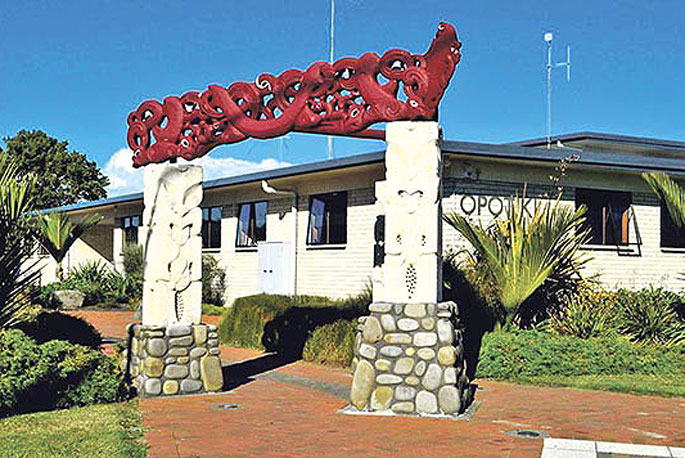Ōpōtiki District Council is at risk of receiving an abatement notice from the Bay of Plenty Regional Council if it does not make improvements to its wastewater treatment facility.
Improvements needed to comply with its resource consent to discharge wastewater are expected to cost more than the council has budgeted for, a council risk and assurance committee meeting heard on Monday.
Meanwhile, council staff are working with the regional council on meeting additional requirements due to population growth when the consent comes up for renewal in 2025.
The Ōpōtiki council holds a resource consent from the regional council to discharge treated wastewater from the Ōpōtiki Wastewater Treatment Plant on to land adjacent to the Waioweka estuary, east of the river mouth.
A screen, Imhoff tank and the oxidation ponds treat the effluent before it discharges to a soakage area via 3km of irrigation lines.
The scheme is one of the few in New Zealand to discharge to land, which is considered a more beneficial way to discharge effluent than to sea, both from a cultural and environmental perspective.
A report received at Monday's meeting by engineering and services group manager Stace Lewer said the regional council's most recent site inspection of the wastewater facility was on June 21.
While there had been no indication of any imminent enforcement action since the last inspection in November, the regional council had changed its grading of the wastewater plant's non-compliance with the consent from moderate to significant.
The regional council defines the grade as indicating there are 'significant environmental consequences and/or a high risk of adverse environmental effects”.
Key issues of non-compliance with the consent were ponding of effluent in certain areas of the disposal field, and wastewater entering the overflow pond more than the allowed 41 days per six months.
Despite the report that followed, Mr Lewer said in his report that it was important to note there had been no confirmed negative impact to the environment.
'[The regional council] recognise that as far as the ponding is concerned there has been no leachate out onto the strand or erosion,” Mr Lewer said at the meeting.
'Similarly with the discharge from the ponds to the overflow pond, if we had had long periods of dry weather instead of wet weather, we would be in a lot better position.”
In response to issues highlighted by the regional council, the district council had engaged a consultant over the past year to undertake an options review of the treatment and disposal process.
The consultant indicated that ponding was being caused by the amount of algae passing through the treatment process. This treatment process needed to be improved to reduce the amount of algae.
'The long-term plan includes $4.8 million in year four for treatment and disposal field upgrades and renewal. There is a risk additional funding will be required for these,” the report said.

The Ōpōtiki wastewater scheme disperses to land through a soakage area between the town and beach.
The issue with the overflow pond was identified as stormwater entering the wastewater system and Mr Lewer said the council had already laid some great groundwork to address these issues through the Inflow and Infiltration reduction project.
This included relining pipelines and doing work on private properties to reduce water getting into the network.
A further $5 million has been budgeted for between 2024-to-2029 to complete the next stage of this work to continually improve the situation.
The consent expires on July 31, 2025. Council staff have commenced planning for the application of a new consent including initial discussions with the regional council.
Three upgrade options were presented to councilors at a workshop in December last year, which would improve the treatment process and distribution over the disposal field. The options range in cost from $12 million to $26 million.
Option A is pond-based treatment with algae removal and UV or ultrafiltration, which has limited growth potential and a large footprint. Option B is pond-based treatment with nutrient reduction, which has a medium footprint and option C is an advanced treatment with a small footprint. These options require further investigation.
Mr Lewer said any new treatment process needed to take into consideration 'growth, the footprint that we have on site and the level of compliance it looks like we are going to need”.
'The good thing is that the assessment has shown that the discharge area is of sufficient size for us to look at the upgrade. It is quite a constrained area, particularly with the urupa next to it. If we have a more advanced treatment process it will allow us to discharge more within the same footprint. The trouble is that comes at a cost. We have some money allocated in the long-term plan, but it is our assessment that it will fall short.”
-Local Democracy Reporting is Public Interest Journalism funded through NZ On Air




2 comments
Here we go again!!
Posted on 04-08-2022 12:26 | By The Caveman
One council using ratepayer money to fight another council with ratepayer money - and unless I have missed something, the ratepayers of the Ōpōtiki District Council are in effect funding BOTH councils !!!
Algae bloom
Posted on 04-08-2022 12:46 | By Kancho
Is a natural occurrence and the huge amount of rain and warm temperatures and flooding entering wastewater is an issue . This will be ongoing but seems the council is doing a good job at planning corrections. There will always be nature changing things and the systems then adapted. So nothing to see here really . We done council
Leave a Comment
You must be logged in to make a comment.